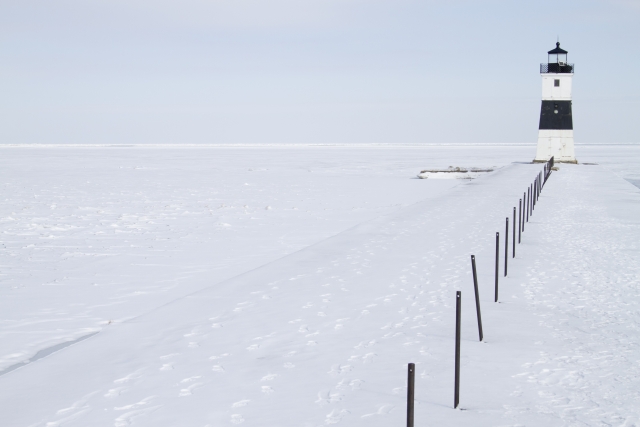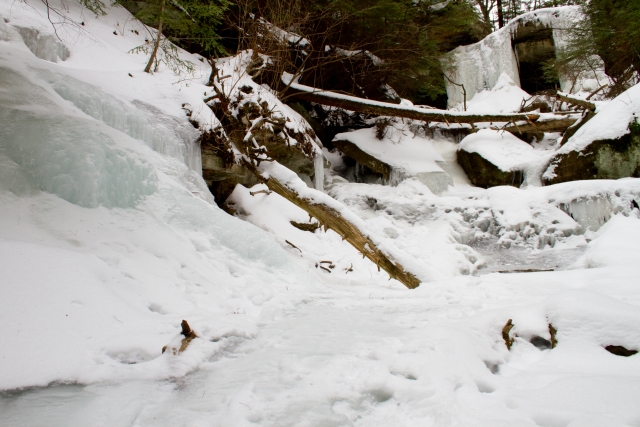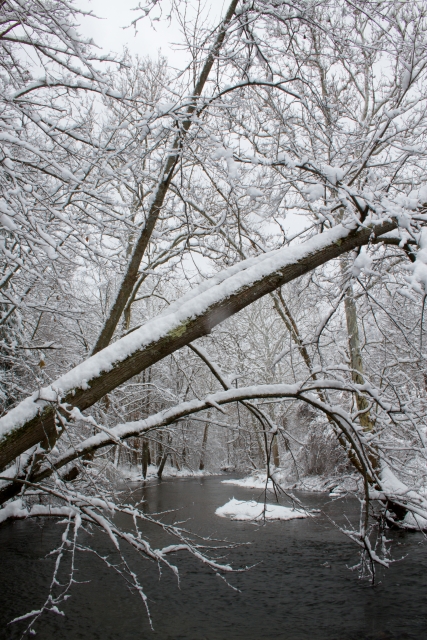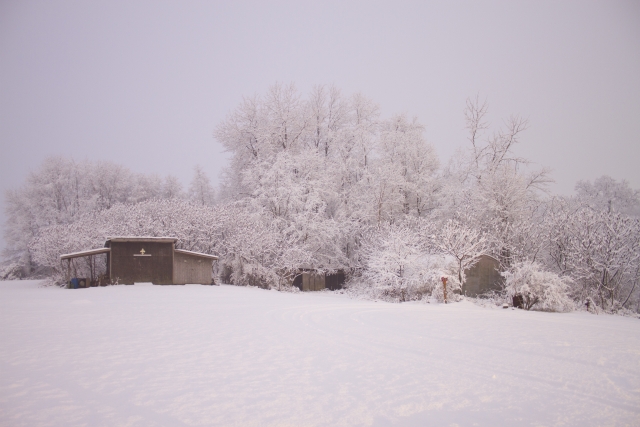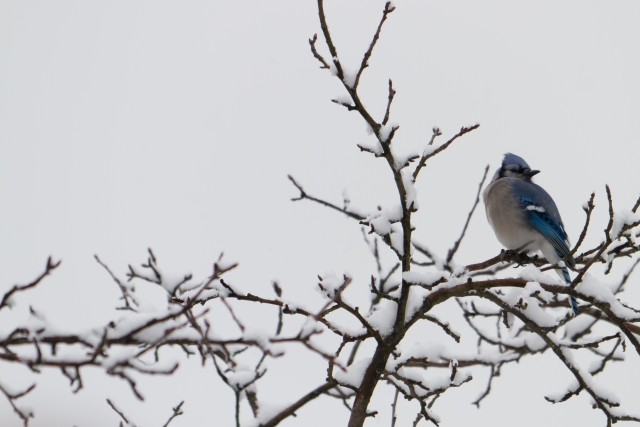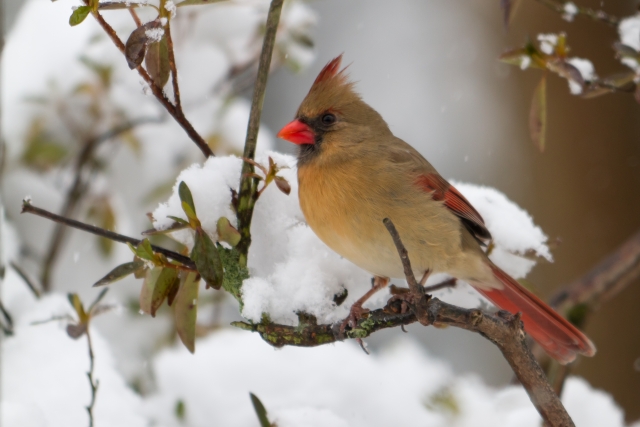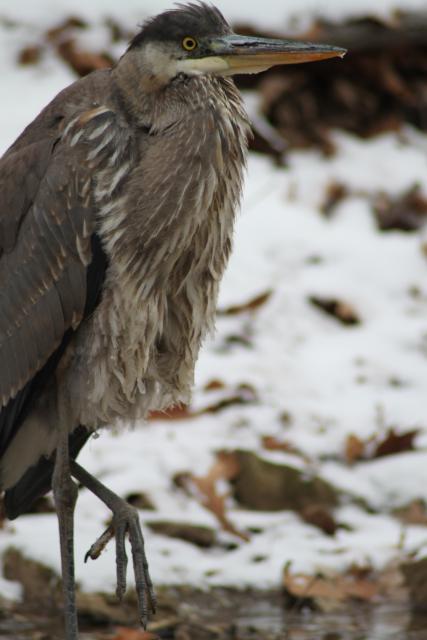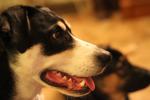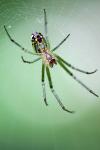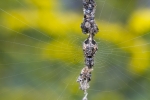snow
Presque Isle Lighthouse
ktuli — Sun, 02/01/2015 - 20:34
We made a trip up to Presque Isle State Park this past weekend to look for Snowy Owls. Apparently we were too late for the owls as they are much harder to find in January, so we'll be trying again in December this year. However, seeing the lake frozen and everything looking like an arctic wasteland was kind of impressive (even if I am 100% sick of winter at this point and ready for spring).
Technical Data: Canon EOS 7D, Canon EF-S 18-55mm f/3.5-5.6 II at 49mm, 1/1000 sec at f/11. ISO 320. RAW processing Adobe Camera Raw.
- Bill
Snow Bird
ktuli — Mon, 01/12/2015 - 18:15
Anya found this cool little imprint in the snow underneath one of her bird feeders.
Technical Data: Canon EOS 7D, Canon EF 100mm f/2.8L Macro IS USM, 1/1600th sec at f/8. ISO 640. RAW processing in Adobe Camera Raw.
With the popularity of The Hunger Games these days, she said it reminded her of the mocking jay logo. Personally, it just reminded me that my fingers were getting cold and I should go back inside!
- Bill
Valentine's Day 2014: More from McConnell's Mills
ktuli — Mon, 02/17/2014 - 07:46
Here's a few more photos from Friday's hike...
Technical Data: Canon EOS 7D, Canon EF-S 18-55mm f/3.5-5.6 II at 22mm, 1/25 sec at f/11. ISO 100. RAW processing Adobe Camera Raw.
Technical Data: Canon EOS 7D, Sigma 10-20mm f/4-5.6 EX DC HSM AF at 10mm, 1/60 sec at f/11. ISO 100. Raw conversion Adobe Camera Raw.
Thanks for stopping by.
- Bill
Valentine's Day 2014: Inside the Frozen Waterfall
ktuli — Sat, 02/15/2014 - 20:08
Anya and I took the day off work on Friday and decided to go on a little hike for Valentine's Day. I figured that if I have to continue to suffer through this winter weather, I might as well make use of it and see if I could get some good photos from it. We headed to McConnell's Mills to find some frozen waterfalls and see how Slippery Rock Creek looked. Then we stumbled upon this beautiful waterfall.
 |
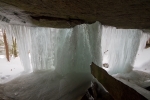 |
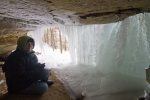 |
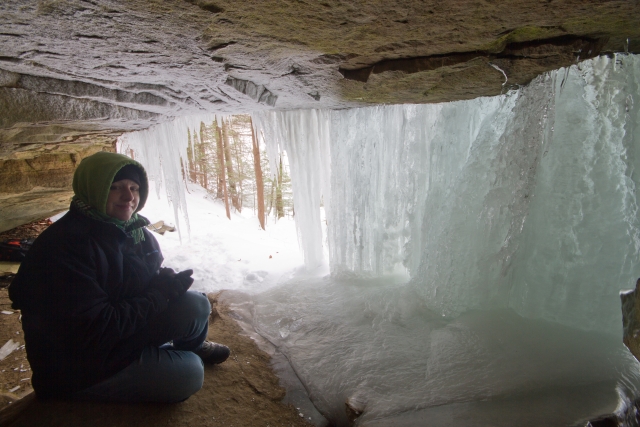 |
||
Technical Data: Canon EOS 7D, Sigma 10-20mm f/4-5.6 EX DC HSM AF at 12mm, 10mm, and 10mm, 1/8th, 1/8th, and 1/4th sec at f/11. ISO 100. Raw conversion Adobe Camera Raw.
Exposure on these shots was pretty difficult with the extremely bright white snow outside and the dark insides of the cavern. I tried using some flash, but really wasn't able to get things just right. Additionally, and probably most impressive was that you could see and hear water still flowing inside that pillar of ice; unfortunately, there simply was no way to capture that with a photo.
I've got as couple more from this trip that I'll share soon.
- Bill
Creek in the Snow
ktuli — Thu, 12/05/2013 - 08:10
Technical Data: Canon EOS 7D, Canon EF-S 18-55mm f/3.5-5.6 II at 18mm, 1/20 sec at f/16. ISO 100. RAW processing Adobe Camera Raw.
Thanks for stopping by!
- Bill
Snow is Coming!
ktuli — Tue, 11/26/2013 - 18:20
OK - just a couple quick and dirty photos tonight... we're supposed to get dumped on with a ton of snow, so I went out this evening and fired off a couple shots to get a "semi" before shot. We already have several inches on the ground, but all the snow sticking up in the branches was so beautiful, I figured I'd capture it real quick. I'll probably try and get out tomorrow when the light is better (these are long exposures to get them bright like that). You might even recognize one of the views...
Technical Data: Canon EOS 7D, Canon EF-S 18-55mm f/3.5-5.6 II at 18mm, 30 sec at f/3.5. ISO 320. RAW processing Adobe Camera Raw.
Technical Data: Canon EOS 7D, Canon EF-S 18-55mm f/3.5-5.6 II at 18mm, 30 sec at f/3.5. ISO 320. RAW processing Adobe Camera Raw.
Stay tuned for more... as long as we can get a door open to get out there tomorrow!
- Bill
Happy New Year 2013
ktuli — Mon, 12/31/2012 - 12:00
Well, we're about to head into 2013. I plan to try and get some work done on the blog this year to get it upgraded to the latest version of the software, so hopefully this will introduce some change to the look/feel. But in the meantime, here are a couple shots I took while freezing my butt off trying to get the birds to come to the feeders for some nice shots of them in the snow...
Technical Data: Canon EOS 7D, Sigma 150-500mm f/5-6.3 APO DG OS HSM at 500mm, 1/160 sec at f/8. OS Mode Off. ISO 100. RAW conversion and cropped in Adobe Camera Raw.
Technical Data: Canon EOS 7D, Sigma 150-500mm f/5-6.3 APO DG OS HSM at 500mm, 1/320 sec at f/6.3. OS Mode Off. ISO 320. RAW conversion and cropped in Adobe Camera Raw.
Technical Data: Canon EOS 7D, Sigma 150-500mm f/5-6.3 APO DG OS HSM at 500mm, 1/250 sec at f/6.3. OS Mode Off. ISO 320. RAW conversion and cropped in Adobe Camera Raw.
Have a great New Years! And we'll see you in 2013!!!
- Bill
Snowflakes
ktuli — Sun, 02/12/2012 - 18:50
I had thought about heading out today to see about finding a place to try some winter wildlife photography - particularly looking for deer in the snow. However, it was just far too cold try do that, so I thought about what I could shoot around here.
I still headed out into the cold, but this time with the MP-E 65mm to see whether I could get any super macro shots of some snowflakes. I'd seen something somewhere (I can't remember where) of photos of individual snowflakes, so I figured I would see if I could do the same.
 |
 |
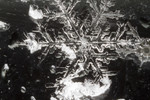 |
 |
||
Technical Data: Canon EOS 7D, Canon MP-E 65mm f/2.8 1-5x Macro, 1, 10, 3.2 sec respectively at f/16. ISO 400. RAW processing in Adobe Camera Raw.
First - finding individual snowflakes is much more difficult than you would think. Any time I would try and look where there was any noticeable amount of snow, it was nearly impossible to distinguish individual flakes. I ended up figuring out that I could find some on the windows of Anya's truck. Even there, I only managed to find maybe half a dozen at a time. And if that wasn't enough of a challenge, I could literally watch the flakes melt in front of me once I did find them.
When I started, I was using my MT-24EX dual macro flash, but I found it was causing far too much in terms of reflections, so I turned it off and went to long exposure times. As you can see, the longest of which went all the way up to 10 seconds.
All of these shots were done at 5x magnification, so dealing with focus was extremely challenging. Anya bought me a macro focusing rail for my birthday, which greatly helped, but at 5x magnification, the slightest movement makes a huge difference in the focus.
This is definitely another subject I'll have to try again in the future - it is just so cool to see such an intricate and unique subject at such magnifications.
- Bill
Spring Buds
ktuli — Tue, 03/08/2011 - 20:28
Yeah - I am still struggling with that lack of motivation, so I'm going to take a little break from the Wakatobi photos for a little bit. I have been looking around at various photography challenge websites as a way to get some inspiration. I found one that was running with the theme of Spring (though I can't seem to find it again), so I grabbed the camera after I got home yesterday and headed out.
I went out with a specific shot in mind, and managed to actually come back with it...
 |
|
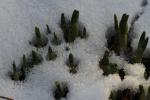 Camera Metered 1/130 sec at f/8 |
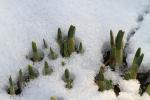 Manually "Over-Exposed" 1/40 sec at f/8 |
Technical Data: Canon EOS 7D, Canon EF 100mm f/2.8L Macro IS USM, 1/130th and 1/40th sec at f/8. Image Stabilization on. ISO 200 (Auto). No post production.
What is being illustrated here is the tendency for cameras to be "confused" by large amounts of bright or dark areas. This frequently happens in snowy scenes or bright sandy beaches being underexposed if you trust the camera's built in meter (ie: if you use auto mode, or even aperture or shutter priority, or even if you use the suggested exposure while in manual mode). In the case of snow, you end up with grey snow.
To fix this, you need to manually "over" expose the image. So yesterday, when I shot these buds bursting up through the snow, the camera's meter exposed the image a little dark and you can clearly see how the white snow appears grey. If you're using manual mode simply nudged the exposure time up a bit, or use your camera's exposure compensation feature, and the result is bright white snow.
I know... if you're like me, you're sick of seeing snow, but I didn't have any bright white tropical beach sand to illustrate this on, so hopefully this little sign of impending spring is enough.
Hopefully it also works to help get me motivated again. and I can get back to more regular posts.
- Bill
PS: Oh - I almost forgot, a similar phenomenon happens in a very dark scene with lots of black. The camera's meter will result in an exposure where the black begins to turn grey. The solution there is simply to "underexpose" a little, and you're all set.
Great Blue Heron
ktuli — Thu, 11/11/2010 - 20:18
I'm working on details for a photo trip out to Cedar Creek Park this weekend with some friends, which had me looking through some other photos from previous trips to this park.
I have another shot of this great blue heron (Ardea herodias), but this wider crop works nicely too.
Technical Data: Canon EOS 7D, Tamron 70-300mm f/4-5.6 Di LD Macro1:2 at 300mm, 1/390 sec at f/5.7. ISO 320. No post production. Cedar Creek Park, Westmoreland County, PA.
Why This Photo: I stumbled on this guy while wandering through the park on a very cold December 30th last year. I instantly switched to my Tamron 70-300 telephoto (my longest lens at the time) and worked on slowly and quietly moving into good position - take photos all along the way.
What Works: For a handheld shot at 300mm, the focus is pretty sharp - especially on the face of the bird. The positioning of the bird's foot gives a bit of a sense of motion as the bird was wading along the stream.
What Doesn't Work: Despite being nicely blurred, the background is still fairly confusing with brown (dirt and leaves) and white (snow) and can be somewhat distracting. Also the crop cutting out the other foot is somewhat unsettling (the same can be argued for the rest of the bird's body, but doesn't seem as bad).
It is kind of unfortunate that I managed this shot in December when the heron did not have its namesake nice blue color, but I wasn't about the pass up the opportunity because of something like that. We saw plenty of blue herons (and even a couple very beautiful green herons) this summer while kayaking, but I didn't have the SLR with me and the SeaLife DC1200 really isn't that functional for shots like this.
Let's hope I can come home with some more new good shots from one of my favorite parks (and hopefully the friends that go with me do too!).
- Bill

